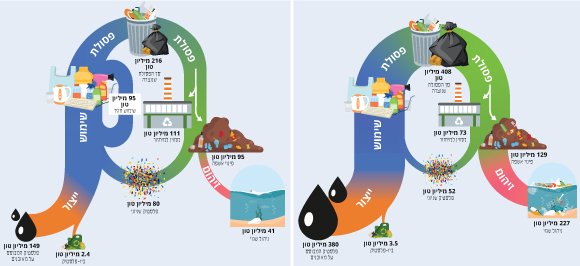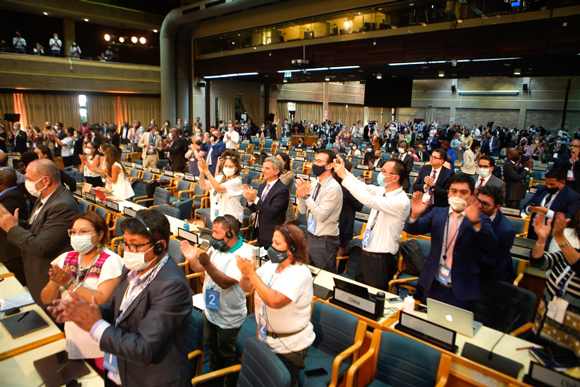World Environment Day, observed this week, in tandem with a week-long series of discussions in Paris,directs its attention towards the urgent fight against plastic pollution. Our natural environment's preservation and the protection of our health are at stake. The imperative to accomplish this goal is non-negotiable, as it holds paramount significance for the welfare of future generations
Imagine a world in which we are not drowning in plastic. A world where sea creatures swim freely, without getting entangled in nets and discarded packaging. A world where birds feed their young only natural food, devoid of any plastic particles. A world where micro-plastic particles cease to accumulate in our bodies and those of all other living creatures. A world where the toxin substances present in plastic no longer pose a threat to us, and our natural ecosystems recover and shield us from the effects of global warming.
Envision a scenario where you barely need to use plastic packaging and disposable utensils.In your supermarket, there are stations for refilling beverage bottles or shampoo containers, and these are made from a handful of plastics that can be reused repeatedly. Governments cease subsidizing the oil industry, making it more cost-effective to collect and recycle our plastic waste. The nations of the world collaborate to clean the plastic that has already infiltrated every nook and cranny, ensuring that all the plastic we produce is treated and free of toxic substances. Furthermore, every passing year introduces innovative alternatives that provide the same functionality, yet with almost no plastic usage.
This is precisely the reality that today’s leaders are striving to enact.

Addressing all stages of the plastic lifecycle is crucial. Scenarios depicting the projected quantities of plastic to be managed in 2040 under the current trend (right) and with implementation of reduction plans (left) | Source: UN report, 2023
Towards a Binding Global Agreement
In a landmark decision last year, the UN Environment Assembly committed to promoting a global convention to combat plastic pollution and to enforce its implementation as early as 2024. The director of the UN Environment Programme (UNEP), Inger Andersen, described the decision as the “most important international multilateral environmental deal since the Paris climate accord [to reduce greenhouse gas emissions]”
This week marked a significant milestone on the path to the desired convention. 700 representatives from 169 countries, gathered to negotiate on collaborative efforts to deal with the escalating plastic pollution. The conference convened in Paris, and was also attended by 900 industry representatives and non-governmental organizations. At the commencement of the event, the chair, Gustavo Meza-Cuadra, stressed that "only through joint action will we be able to overcome plastic pollution," and called for immediate action towards an ambitious and binding global agreement. Despite the challenging negotiations due to conflicting interests among nations, success was ultimately achieved. Country representatives authorized the UNEP team to prepare an initial draft for the global agreement.
The draft is expected to encompass a broad range of potential measures to reduce pollution, allowing the complex negotiations to continue in November and in two additional meetings next year. In the meantime, Andersen urged nations worldwide to maintain momentum toward the global convention. In her view, “The world is calling for an agreement that is broad, innovative, inclusive and transparent, one that leans on science and learns from stakeholders, and one that ensures support for developing nations."

Kickoff Celebrations. What lies ahead? Participants of the UN Environment Assembly in Nairobi celebrate the approval of the resolution on combating plastic pollution. Now, the crucial task of implementation awaits. | Photo: UNEP
A One-Time Opportunity
We currently produce about half a billion tons of new plastic a year, and the production rate continues to grow rapidly. Unless we make drastic changes, we'll be producing double the amount of plastic by 2050. This would also triple the quantity of plastic that reaches the sea, exacerbating the environmental and health damages it causes. Hence, it's crucial to act promptly and decisively now.
According to Andersen, the success of the agreement requires adopting an approach that addresses all stages of a plastic product’s lifecycle, one that reduces both the need for plastic and its utilization, rather than merely improving recycling and waste management. “The truth is we cannot recycle our way out of this mess. Recycling infrastructure is unable to cope with today’s volumes. Waterfalls of virgin plastic are cascading into the system at one end. Our recycling systems are akin to running around with pots at the other end, catching only a fraction of this torrent to put back into the system” Andersen said, “Simply investing in bigger pots and more people to carry them will not fix the problem.” Indeed, to date we have managed to recycle less than eight percent of all the plastic we have produced.
Andersen added that "plastic has been the default option in design for too long. It's time to redesign products to contain less plastic, especially problematic plastic or unnecessary plastic. It is time for chemists, manufacturers and process engineers to get creative. It is time for governments to get creative. It is time for consumers to get creative. Only a determined elimination of unnecessary plastic, a full redesign of the products that we envelop in plastic and a full market transformation that drastically reduces the flow of virgin plastics [can potentially fix the situation]. Redesign products to use less plastic – particularly unnecessary and problematic plastics. Redesign product packaging and product shipping to use less plastic. Redesign systems and products for reuse and recyclability.” Andersen also underscored the importance of battling the rise of single-use products, which pose a particularly significant environmental pollution.
In addition, a special UN report, published ahead of the conference, outlines a quantitative roadmap for reducing plastic pollution relying on existing technologies and solutions. According to the report, pollution can be curtailed by 80 percent by 2040. The most straightforward solution, reuse, could contribute to approximately 30 percent reduction in pollution. Another 20 percent reduction could be achieved by expanding recycling after implementing broad systemic changes, and an additional 17 percent could be attained by transitioning to alternative products. These measures would enable a halving of single-use product production without sacrificing the practicality of plastic. Adopting appropriate policies could also lead to global savings of up to 4.5 trillion dollars.
Andersen's words did not fall on deaf ears. Island nations, which are particularly afflicted by plastic pollution, also called for immediate action. They formed an ambitious coalition with the European Union, Japan, and other countries, calling for the setting of global targets for reducing plastic production and pollution while also restricting the use of certain materials. Conversely, countries such as the United States and Saudi Arabia, known for their substantial oil industries, advocated for individualized plans for each nation and opposed the establishment of global targets. Saudi Arabia, Russia, and China also opposed majority-based decision-making and insisted on adopting decisions only through unanimous consent. The demand for consensus would enable countries holding minority opinions to veto decisions.

World plastic production is increasing rapidly, with annual output projected to double by 2050, unless action is taken. The rate of recycling is failing to keep pace | Source: UN Environment Programme Report, 2021, Illustrated by GRID-Arendal
Protecting the Environment and Humanity
World Environment Day, celebrated on June 5, supplements the Paris discussions by advocating for an intensification of the global fight against plastic pollution. This day, along with the ongoing debates surrounding a global treaty, emphasizes the significance of environmental protection and the crucial role of governments in this regard. It is important to understand that environmental crises are interlinked and mutually influential. A decrease in plastic consumption would not only reduce its related greenhouse gas emissions but also lessen the damage inflicted on our ecological systems. It's crucial to remember that we, as humans, are an integral part of the environment; we impact it and, in turn, are deeply affected by it, relying on it for our survival. It's a lamentable reality that these environmental crises hit the most vulnerable populations the hardest.
World Environment Day underscores that each of us has the power to improve the environmental situation and our quality of life. Comparable to the actions needed in order to mitigate the climate crisis, personal responsibility and behavior change are crucial in addressing the issue of plastic. Nevertheless, our decision-makers have a substantially more significant role, and only they have the capability to lead the required systemic change. Local authorities, government ministers, industry leaders, everyone has a part to play in facilitating this change. While world leaders are deliberating and debating on the optimal courses of action, it is imperative that we do not remain apathetic. We have the ability to act, both collectively and individually, and to demand that our public representatives serve the public interests.
Short video on the impact of plastic and its consequences (English):
